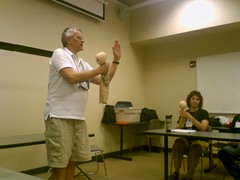
I'm sure you are all panicking by now, thinking that I wasn't going to tell you about the second day of the workshop. Ah such little faith! I was just tired to day, but I'm ready now.
Luman Coad talked a great deal about movement. He advised us to use silence or put in pauses to draw attention to the motion you want clear.
For example, picking up an object might go something like this:
Look at it
Pause
Examine it
Pause
Consider how to lift it
Pause
Put the hands on it
Pause
Tighten the hold
Pause
Lift or heft it
Pause
Walk off with it
He had four things he encouraged us to think about when creating movement:
A. Size
B. Speed
C. Energy
D. Style
When developing movement, try to:
a. Observe people, study what catches your attention about a movement they make
b. Analyze the movement or determine what it is that is unique about it.
c. Simplify it or "Boil it down" to the essential motion
d. Rehearse and experiment the motion with the puppet
e. Apply it to the character--no two puppets will move the same way
f. Refine the movement:
i. How's the speed? Too fast? Too slow?
ii. How does it fit into the rhythm of the series of movement around it.
iii. Determine what effects the energy of the motion:
--The age of the puppet.
--The temperature of the day.
--The mood of the character.
--etc.
iv. Consider clarity--you only have one chance to make sure an audience gets it
v. Give your audience a chance to think, don't rush them through the story.
vi. Consider the size of the movement in relation to the time frame of the story; mix it up; build it up; pull audiences up.
vii. Use follow-through--like in cartoons--step back before rushing forward--the "ready, set, go" method. This is an idea of the action reaction. In the series of picking an object up I listed above, this would be the "tighten the hold" part.
viii. Use contrast--big/small, bold/shy, happy/sad--to get the point across.
Our homework was to watch the performances that day for "sequences of movement that reveal characterization". Also, we are to come up with a sequence of movements to reveal a stereotypical fairytale character--communicate this with motions only. I think I'll go with the village idiot.







No comments:
Post a Comment